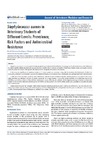Identificador persistente para citar o vincular este elemento:
https://accedacris.ulpgc.es/handle/10553/56489
| Título: | Staphylococcus aureus in veterinary students of different levels: prevalence, risk factors and antimicrobial resistance | Autores/as: | Herrera-Rodríguez, Daniel González-Martín, Margarita Tejedor-Junco, María Teresa |
Clasificación UNESCO: | 2414 Microbiología 310907 Patología |
Palabras clave: | Staphylococcus aureus Resistance Pathogenicity factors Students |
Fecha de publicación: | 2018 | Publicación seriada: | Journal of Veterinary Medicine and Research | Resumen: | Staphylococcus aureus is a coccus housed in healthy people but also implicated in fatal infections. The emergence of multi-resistant strains, like MRSA, lead to a highly specific antibiotic treatment and produce prominent mortality rates, in animals and mankind. Veterinarians, health workers, and people who have continued contact with animals suffer greater risks because of the interspecies transmission of the bacteria. In this study, the significance of veterinary students as S. aureus carriers was evaluated, along with its prevalence, the Erythromycin, Enrofloxacin, Doxycycline, Gentamicin and Amoxicillin-Clavulanic Acid resistance featured, and its molecular basis. Additionally, some pathogenicity factors were evaluated. A 44% of S. aureus prevalence was found. None of the factors collected showed a statistical correlation with the presence or non-presence of S. aureus. Slime production was detected in 45.45% of isolates. Among the 22 S. aureus isolates, 10 (45.45%) showed resistance or an intermedius result to one (36.36%), two (4.54%) or three (4.54%) antibiotics. Erythromycin was, by difference, the antibiotic with the highest percentage of resistant or intermedius isolates (10/22, 45.45%), followed by Enrofloxacin (2/22, 9.09%) and Doxycycline (1/22, 4.54%). All the isolates were susceptible to Amoxicillin-Clavulanic Acid and Gentamicin. All the isolates harboured the 16st genes. Three isolates harboured Erythromycin resistance genes (13.63%), two of them ErmC, and one ErmB and ErmC. Three of the isolates harboured Tetracycline resistance genes, all of them TetK (13.63%). The pathogenicity factor PVL gene was detected in only one isolate (4.54%). The pathogenicity factor ACME gene was detected in four isolates (18.18%). | URI: | https://accedacris.ulpgc.es/handle/10553/56489 | ISSN: | 2378-931X | Fuente: | Journal of Veterinary Medicine and Research [ISSN 2378-931X], v. 5 (7), 1149 |
| Colección: | Artículos |
Visitas
146
actualizado el 31-oct-2024
Descargas
156
actualizado el 31-oct-2024
Google ScholarTM
Verifica
Comparte
Exporta metadatos
Los elementos en ULPGC accedaCRIS están protegidos por derechos de autor con todos los derechos reservados, a menos que se indique lo contrario.
